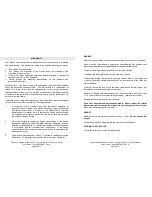
Subject to change without notice. Copyright @ 2013. Sunrise Medical.
User Guide – Rolling Walkers. Rev. A
Page 2 of 11
WARNING
For your safety and before each use, please perform the daily checks as
described in the maintenance section, and in addition:-
1.
Ensure the rollator is securely locked open before use. ie.
Seat pad is
fully down
.
2.
Do not overload the basket or carry heavy bags on the handles as this
can affect the stability of the walker.
3.
Do not use your walker until the handles are properly adjusted and
securely tightened.
4.
Do not extend the handle beyond the knurling on the handle’s tubing;
doing so may result in loss of support and handle failure.
5.
Always lock brakes when sitting on the walker. i.e.
brake handles are
pushed fully down with an audible click
6.
Do not sit on the walker if the ground is sloped or uneven.
7.
Do not exceed the maximum user weight capacity listed on the walker.
8.
Do not use this walker as a wheelchair. Doing so may cause a tip-over,
resulting in injury.
WALKING WITH THE ROLLATOR
1.
Place rollator ahead of you with brakes parked.
i.e. brake handles
pushed fully down with an audible click (see Figure 1)
2.
Do not walk forward until you have tested your balance and you feel
strong enough to walk.
3.
When ready, disengage the brakes
i.e. brake handles pulled up with an
audible click (see Figure 2)
4.
Gently roll the walker ahead of you as you walk. Keep the rollator close
enough to you that it is supportive.
5.
If your steps are uneven, it’s best to shorten your longer step rather than
try to lengthen your shorter step.
The shorter step is usually the step
where you have less balance.
6.
Use the brakes
i.e. squeeze the brake handles (see Figure 3) to
temporarily halt forward movement, or to slow and control the frame,
and/or reduce the speed of your step.
CAUTION:
Some very smooth surfaces e.g. marble, tile or certain floor
coverings, may cause the rollator wheels to slide even with the brakes applied.
This page is intentionally blank.


























